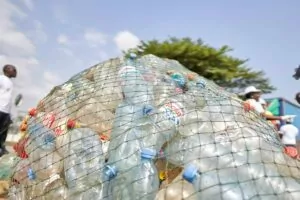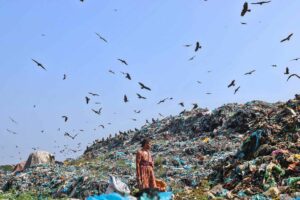The Great Pacific Garbage Patch, a vast accumulation of marine plastic debris, has garnered significant attention in recent years. Situated in the North Pacific Ocean, this floating garbage mass highlights the alarming extent of plastic pollution and its detrimental effects on marine ecosystems.
 The Great Pacific Garbage Patch, often described as a “plastic soup,” is an enormous accumulation of plastic debris that spans an area estimated to be as large as 1.6 million square kilometres. It is located between Hawaii and California, with currents in the North Pacific Gyre bringing in plastic waste from various parts of the world. The patch consists of both large and small plastic pieces, including bottles, bags, fishing nets, and microplastics, making it a significant threat to marine life.
The Great Pacific Garbage Patch, often described as a “plastic soup,” is an enormous accumulation of plastic debris that spans an area estimated to be as large as 1.6 million square kilometres. It is located between Hawaii and California, with currents in the North Pacific Gyre bringing in plastic waste from various parts of the world. The patch consists of both large and small plastic pieces, including bottles, bags, fishing nets, and microplastics, making it a significant threat to marine life.
The presence of the Great Pacific Garbage Patch poses severe threats to marine ecosystems. Marine creatures, such as seabirds, turtles, and whales, often mistake plastic debris for food or become entangled in fishing nets and other discarded items. Ingesting plastic can lead to internal injuries, blockages, malnutrition, and even death. The accumulation of microplastics in the patch further magnifies the problem, as these tiny particles are ingested by smaller organisms, eventually entering the food chain and potentially affecting larger marine species, including humans.
 The Great Pacific Garbage Patch is a result of various factors, including inadequate waste management practices, improper disposal of plastic products, and the sheer volume of plastic production worldwide. Plastic waste generated by coastal communities, shipping vessels, and fishing activities is carried by ocean currents to the patch, contributing to its growth. Additionally, litter and debris from land-based sources, such as rivers and storm drains, find their way into the ocean, exacerbating the problem.
The Great Pacific Garbage Patch is a result of various factors, including inadequate waste management practices, improper disposal of plastic products, and the sheer volume of plastic production worldwide. Plastic waste generated by coastal communities, shipping vessels, and fishing activities is carried by ocean currents to the patch, contributing to its growth. Additionally, litter and debris from land-based sources, such as rivers and storm drains, find their way into the ocean, exacerbating the problem.
Efforts are being made to address the Great Pacific Garbage Patch and the broader issue of plastic pollution. Cleanup initiatives, such as The Ocean Cleanup Project, aim to remove plastic debris from the ocean. Governments and organizations worldwide are implementing policies to reduce single-use plastics, promote recycling, and develop more sustainable packaging alternatives. Individual actions, such as reducing personal plastic consumption, participating in beach cleanups, and supporting organizations advocating for change, also play a crucial role in combating the problem.
The Great Pacific Garbage Patch represents the magnitude of plastic pollution and its impact on marine ecosystems. It serves as a call to action, urging individuals, businesses, and governments to prioritize sustainable practices, reduce plastic waste, and work collectively towards a cleaner and healthier marine environment.






